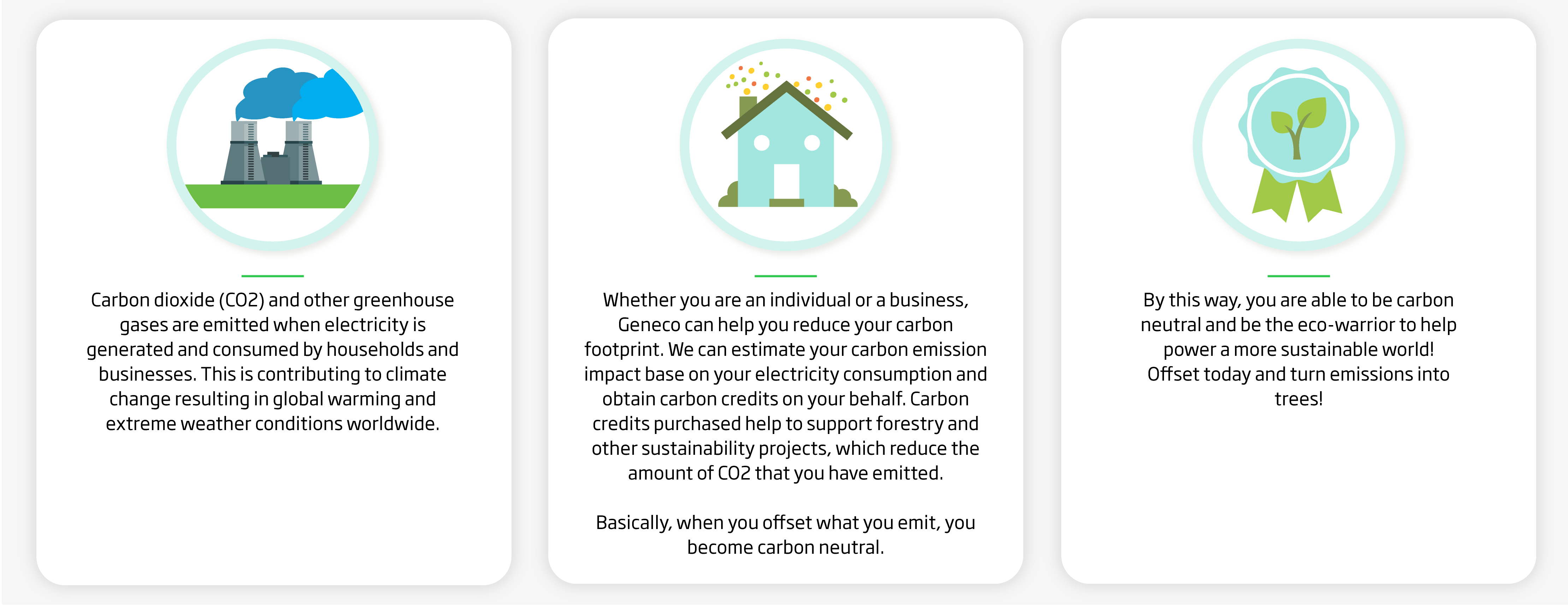- Home
- Residential
- Blog
- Carbon Neutral Electricity Explained
[Post Date]
Carbon Neutral Electricity Explained

A brief introduction to carbon emissions
Since the Industrial Revolution, sources of carbon emissions have increased. Human activities have led to a sharp and dangerous increase in these emissions, mainly through fossil fuel combustion in the electricity and heat, transportation and industrial (consisting of manufacturing, construction, mining and agriculture) sectors.
Carbon emissions make up 97% of Singapore’s greenhouse gas emissions. These emissions cause more heat to be trapped in the atmosphere, leading to climate change. This interesting video created by researcher Antti Lipponen, from the Finnish Meteorological Institute, used publicly available data from NASA to demonstrate the rising temperatures, or global warming, across the world.
These are some of the few repercussions of global warming:
- Widespread melting of snow and ice around the world
- Rise in global sea levels
- Ocean acidification
- Coral bleaching
- Increased flooding
- Longer droughts
- More frequent cold waves and heat waves
- Stronger storms, cyclones and hurricanes
These effects, in turn, lead to a decrease in crop yield, famine, loss and extinction of flora and fauna on land and under the sea, threatened water supplies, rise in water, food and insect borne diseases, and many other issues.


What is Singapore doing to help?
Singapore experiences the effects of climate change along with the rest of the world. The buildup of carbon dioxide in the atmosphere makes our weather hotter and raises the sea level around us too.
Reducing our carbon emissions is one important way of limiting the effects of climate change in the coming decades. As a responsible member of the global community, Singapore has pledged to reduce our greenhouse gas emissions by 16% below Business-As-Usual levels in 2020. The pledge, announced in 2010 ahead of the UNFCCC Climate Change Conference in Copenhagen, was conditional on a legally binding global agreement. Singapore has also ratified the UN Framework Convention on Climate Change in 1997, acceded to the Kyoto Protocol in 2006 and to the Paris Agreement in 2015.
Within Singapore, energy consumption is one of the main sources of carbon emissions. Our household appliances, transport systems, industrial and commercial activities all run on electricity and fuel.
Over the years, Singapore has switched to being less reliant on carbon-intensive fuel oil, using more natural gas instead. This means that Singapore can continue to be powered, while emitting less carbon. However, there are limits to how much further we can reduce emissions, since natural gas already constitutes more than 95% of our fuel mix for electricity generation today. Therefore, improving energy efficiency is key in our efforts to reduce emissions.
How are carbon emissions linked to my use of electricity?
Conventional electricity is generated through the burning of fossil fuels and this process results in the release of carbon dioxide equivalent (CO2e) gases into the atmosphere. By using electricity, consumers indirectly contribute to these emissions.
How much carbon does a typical household indirectly emit from the use of purchased electricity?
Based on an average Singapore household consumption of 450 kWh of electricity per month, around 2.2 metric tonnes of carbon dioxide equivalent gases are estimated, per household, to be emitted to the atmosphere in a year.
How can I reduce my carbon footprint?
In order to reduce your carbon footprint, you first need to understand the extent of your carbon footprint. You can learn more about your estimated carbon footprint using a simple online calculator.
You can reduce your carbon footprint by making conscious and mindful decisions about your lifestyle. This would result in lower energy use, lower emissions and a better world for future generations.
Here are four ways to get you started:
Image Credits: Nylon Coffee Roasters
Source: The Sustainability Project
References:
- 1 (2019) Climate Healers, Animal Agriculture is the Leading Cause of Climate Change – A Position Paper https://climatehealers.org/the-science/animal-agriculture-position-paper/

1. At Home
Minimise your household carbon emissions by using energy, water and other resources carefully. Adopt some green ways to reduce your household energy usage.

2. Transportation
Take public transport instead of driving. If your destination is nearby, walk or cycle.
If you have to drive, choose a car that emits less carbon. Look out for the mandatory Fuel Economy Labelling Scheme (FELS) labels. These will tell you more about the amount of carbon emitted and fuel efficiency performance of the car model. With the enhanced Vehicle Emissions Scheme (VES) effective from 1 January 2021, you will also get to enjoy a rebate when you buy a vehicle that emits less carbon.

3. Reduce, reuse and recycle
By choosing to use less, less will go to waste. When we do throw things away, we can make sure our waste gets reused by recycling materials such as paper, metal, plastic and glass.
Using recycled products can also help reduce carbon emissions, because it takes less energy to produce them.
Avoid using disposable utensils, cups and plastic bags whenever possible. Reduce waste by bringing your own utensils for meals and using your own reusable bag for grocery shopping. Also, consider whether you really need the packaging or wrapping when you buy things.
Watch this 71-year-old grandmother take on the 7-day zero-waste and plastic-free challenge.

4. Utilise carbon credits
Carbon credits are completely voluntary. Individuals and businesses can purchase carbon credits to balance out their carbon footprint.
In a nutshell, carbon credits let you pay to avoid/reduce the carbon emissions, instead of making radical or impossible reductions of your own.
When you buy credits, you fund projects that reduce carbon or greenhouse gas emissions. Some examples of these projects include renewable energy projects, updating power plants and factories, or increasing the energy efficiency of buildings and transportation.
What are carbon credits?
Carbon credits (or carbon offset) are credits given for greenhouse emissions reduced or removed from the atmosphere by an emission reduction project, and which can be used by governments, industry or private individuals to compensate for the emissions they are directly and/or indirectly generating.
How do carbon credits work?
While there are different types of carbon credits available in the market, they all work in similar manner. One of the most widely issued carbon credits are the Verified Carbon Units (VCUs) issues to projects developed under the Verified Carbon Standard (VCS) Program.
Through the VCS Program, more than 1,300 certified VCS projects have collectively reduced or removed over 200 million tonnes of carbon and other GHG emissions from the atmosphere.
Projects developed under the VCS Program must follow a rigorous assessment process in order to be certified and include a wide variety of technologies and measures which result in GHG emission reductions and removals. These projects are categorized by their sectoral scope, which range from renewable energy projects to land use projects.
All VCS projects are subject to desk and field audits to ensure that standards are met and methodologies are properly applied. Projects are assessed using a technically sound GHG emission reduction quantification methodology specific to that project type.
Once projects have been certified, project developers are issued VCUs, with one VCU representing one metric tonne of carbon-equivalent emissions reduced or removed from the atmosphere.
Purchasing and retiring these VCUs allow individuals and companies to offset their own emissions. Carbon neutrality is achieved when emissions are fully offset.
Parties interested in purchasing and retiring these VCUs, use the trusted and secure platform, the Verra Registry, which was launched in April 2020 and is the cornerstone for the implementation of VCS standards and programs. Geneco is one such party, and strive to provide our customers with carbon credits of similar or even higher standard of assessment and quality assurance.
How does Geneco support the reduction of carbon emissions?
In the UK, Geneco is acclaimed for its work in recycling and renewable energy. Landfills of junk and waste are used to power homes, buses, cars and more. We have won 13 awards for our green efforts, including National Recycling Awards for both 2015 and 2016, British Renewable Energy Awards for both 2015 and 2017, and many more.
Geneco brings this same expertise to the Singapore Open Electricity Market, giving consumers a choice to build a sustainable energy future through the purchase of a carbon neutral electricity price plan.
